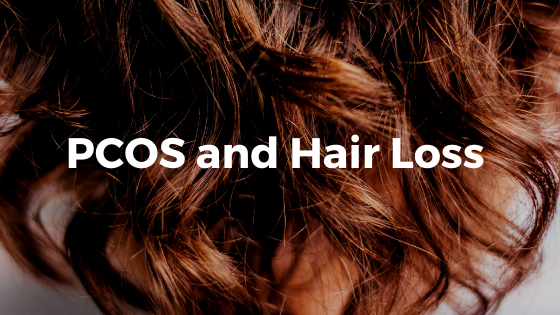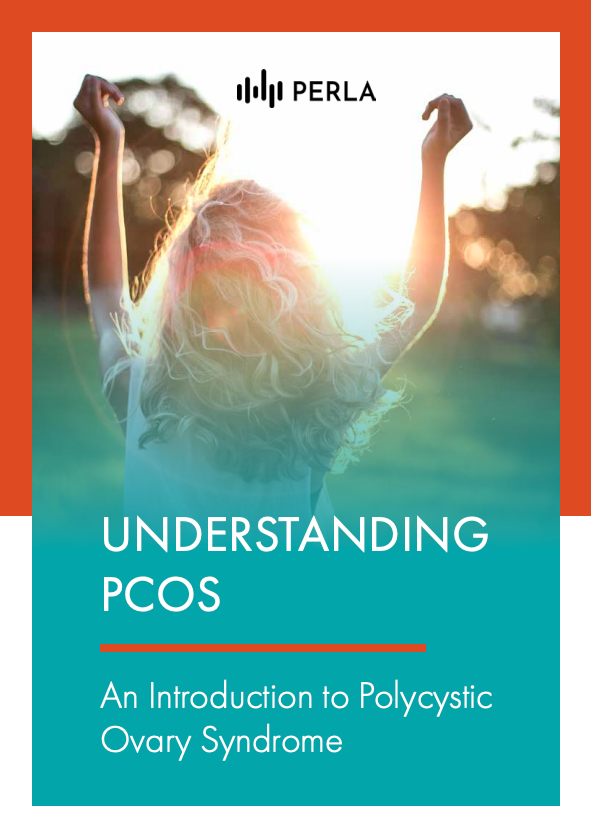There are two distinct types of hair problems experienced by women with polycystic ovary syndrome (PCOS): excess hair growth, which mainly affects the body and face, and hair loss, which affects the scalp. The medical term for this type of hair loss is androgenetic alopecia, also known as male pattern hair loss or female pattern hair loss. While not exactly reversible, there are many ways to stimulate hair growth in women with PCOS-related hair loss. Let’s dive right in:
Understanding Hair Loss in PCOS
Female pattern hair loss is characterized by gradual thinning at the part line, usually intact frontal hairline, and diffuse hair loss from the top of the head.1 Men, on the other hand, may start to lose hair above the temples, then the hairline gradually recedes and forms an “M” shape.2
If your hair is thinning, the first thing to do is to talk to your primary provider or dermatologist. If you have been diagnosed with PCOS, you should tell your doctor or your PCOS care team about your hair loss. They would be able to suggest the next best step to take and what treatment options are available for you.
What Causes Hair Loss in PCOS?
Hair loss has many causes—physical and emotional stress, high fever, poor nutrition, sickness, and certain medications, to name a few. But in women with PCOS, the primary trigger is the level of androgens or male hormones.3 The three main androgens are androstenedione, testosterone, and dihydrotestosterone. We are particularly interested in the latter two: testosterone and its more potent metabolite, dihydrotestosterone.
Both men and women produce these androgens, so both can suffer from androgenetic alopecia. However, there are three big differences between the genders concerning androgens.
- Men produce testosterone from their testes whereas women produce it from their ovaries and adrenal glands.
- Men produce more testosterone than women.
- Men have a far greater number of chemical receptors in the body’s tissues that respond to these hormones. But women are more sensitive to it than men.
Even a slightly elevated level of male hormones can cause symptoms of hyperandrogenism in women, including acne, hirsutism, and alopecia.
The Role of Dihydrotestosterone (DHT)
The free testosterone in the blood is oxidized and converted to DHT, the hormone that stimulates hair follicles to grow. But how does it lead to both hair growth and hair loss in women?
It appears that androgens have different effects on hair follicles. They stimulate hair growth in some areas such as the beard, armpits, and pubic areas and suppress growth in the scalp of genetically susceptible individuals.4
In some people, the hair follicles in the scalp are oversensitive to testosterone, and higher levels lead to hair loss instead of hair growth. The reason for this is not clear. It is believed that the sensitivity of your hair follicles is dictated by your genes.5 The risk for female pattern hair loss is said to be higher for women with a history of alopecia on either side of the family.
Can you Regrow Hair Loss from PCOS?
Hair loss from androgenetic alopecia occurs because the hair’s anagen (growing) phase is shortened and the time between the shedding phase and the next anagen phase is prolonged. So it takes longer for the hair to grow back after it is shed.
Androgens also alter the hair follicles in a process called “follicular miniaturization,”6 causing them to shrink and produce thinner, fragile hairs that are prone to breakage.
Over time, hair becomes thinner and thinner until the follicles wither away. Hair that is lost in this process will not grow back. But if the follicles are intact, many available treatments can promote the growth of new hair shafts.
How to Manage PCOS-related Hair Loss
Current treatment for hair loss in PCOS is aimed at managing the underlying hormone imbalance using oral contraceptives and medications with antiandrogenic activity plus supportive topical treatment. PCOS guidelines recommend topical minoxidil as the first-line treatment.7 There are other options that your doctor or healthcare provider might mention when discussing treatment options for hair loss with you:
Medications
- Oral contraceptives can lower androgen levels, which can slow hair shedding and help with other PCOS symptoms.
- Spironolactone is a diuretic with anti-androgen activity. It is more effective when added to an oral contraceptive.
- Minoxidil is the only topical medication approved by the FDA for female pattern hair loss. It is applied directly to the scalp to stimulate hair growth.
Laser therapy
Low-level laser therapy (LLLT) appears to be effective in treating androgenic alopecia in both men and women.8 A handheld device called HairMax® LaserComb was approved by the FDA in 2007 for this indication. In 2016, the iRestore Hair Growth System was given clearance to market by the FDA. It is a head cap that promotes hair growth in women with female pattern hair loss.
Conclusion
If your hair loss is affecting your emotional and psychological well-being, talk to your doctor, healthcare provider or care team about the issue, they can suggest treatment approaches to try. Also think about joining a support group, as there are many women that suffer from the same symptoms. Remember that hair takes time to grow, so do not be discouraged if you don’t see the results right away.
Sources:
- Trüeb RM. Female Alopecia. Springer Berlin Heidelberg; 2013. doi:10.1007/978-3-642-35503-5
- Wirya CT, Wu W, Wu K. Classification of Male-pattern Hair Loss. Int J Trichology. 2017;9(3):95-100. doi:10.4103/ijt.ijt_46_17
- Kovacs GT, Norman R, eds. Polycystic Ovary Syndrome. 2nd ed. Cambridge University Press; 2001. doi:10.1017/CBO9780511545191
- Randall VA. Androgens and hair growth. Dermatol Ther. 2008;21(5):314-328. doi:10.1111/j.1529-8019.2008.00214.x
- Fabbrocini, G., et al. “Female Pattern Hair Loss: A Clinical, Pathophysiologic, and Therapeutic Review.” International Journal of Women’s Dermatology, vol. 4, no. 4, Dec. 2018, pp. 203–11. ScienceDirect, doi:10.1016/j.ijwd.2018.05.001.
- Yazdabadi A, Magee J, Harrison S, Sinclair R. The Ludwig pattern of androgenetic alopecia is due to a hierarchy of androgen sensitivity within follicular units that leads to selective miniaturization and a reduction in the number of terminal hairs per follicular unit. Br J Dermatol. 2008;159(6):1300-1302. doi:10.1111/j.1365-2133.2008.08820.x
- Gainder S, Sharma B. Update on Management of Polycystic Ovarian Syndrome for Dermatologists. Indian Dermatol Online J. 2019;10(2):97-105. doi:10.4103/idoj.IDOJ_249_17
- Jimenez JJ, Wikramanayake TC, Bergfeld W, et al. Efficacy and safety of a low-level laser device in the treatment of male and female pattern hair loss: a multicenter, randomized, sham device-controlled, double-blind study. Am J Clin Dermatol. 2014;15(2):115-127. doi:10.1007/s40257-013-0060-6


